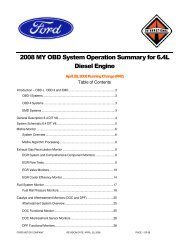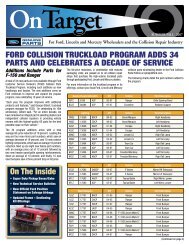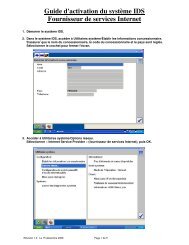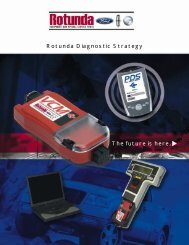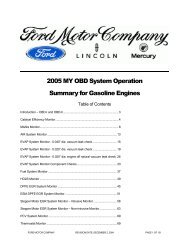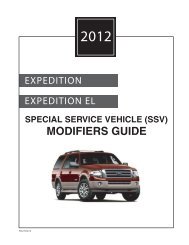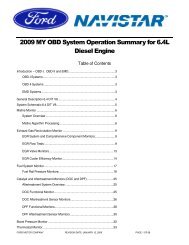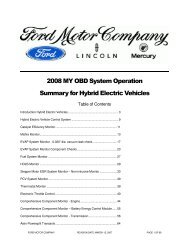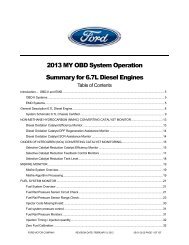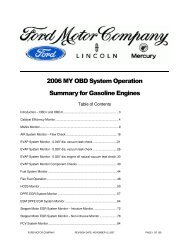OBD Operation Summary for Fiesta - MotorCraftService.com
OBD Operation Summary for Fiesta - MotorCraftService.com
OBD Operation Summary for Fiesta - MotorCraftService.com
- No tags were found...
Create successful ePaper yourself
Turn your PDF publications into a flip-book with our unique Google optimized e-Paper software.
Cold Start Emission Reduction System MonitorThe Cold Start Emission Reduction System Monitor was introduced <strong>for</strong> the 2007 MY on vehicles that meet the LEV-IIemission standards. It replaces the Cold Start Emission Reduction Component Monitor. The Cold Start EmissionReduction (CSER) Monitor detects the lack of catalyst warm up resulting from a failure to apply sufficient CSER during acold start. It does this by using the inferred catalyst temperature model to determine how closely the actual catalysttemperature follows the expected catalyst temperature during a cold start. How closely the actual temperature followsthe expected temperature is reflected in a ratio which is <strong>com</strong>pared with a calibratable threshold.Temperatures UsedThe actual catalyst temperature is the same inferred catalyst temperature that is used by other portions of the enginecontrol system, including the CSER control system. The inputs to this actual temperature are measured engine speed,measured air mass, and <strong>com</strong>manded spark.The expected catalyst temperature is calculated using the same algorithm as the actual catalyst temperature, but theinputs are different. Desired engine speed replaces measured engine speed, desired air mass replaces measured airmass, and desired cold start spark replaces <strong>com</strong>manded spark. The resulting temperature represents the catalysttemperature that is expected if CSER is functioning properly.Ratio CalculationA ratio is calculated to reflect how closely the actual temperature has followed the expected temperature. This ratio isthe difference between the two temperatures at a certain time-since-start divided by the increase in expectedtemperature over the same time period. The ratio, then, provides a measure of how much loss of catalyst heatingoccurred over that time period.This ratio correlates to tailpipe emissions. There<strong>for</strong>e applying a threshold to it allows illumination of the MIL at theappropriate emissions level. The threshold is a function of ECT at engine start.General CSER Monitor <strong>Operation</strong>During the first 15 seconds of a cold start, the monitor checks the entry conditions, counts time in idle, and observescatalyst temperature.If the expected change in catalyst temperature is large enough, the monitor calculates the ratio as described above.Otherwise the monitor does not make a call.The monitor then begins the waiting period, which lasts from the time the ratio is calculated (15 seconds after enginestart) until 300 seconds after engine start. This 5-minute wait allows time to diagnose other <strong>com</strong>ponents and systemsthat affect the validity of the catalyst temperature model. During this waiting period, there are no constraints on drivecycle and the monitor cannot be disabled without turning off the key.At the end of the waiting period, if no other faults that could <strong>com</strong>promise the validity the catalyst temperature model arefound, the monitor <strong>com</strong>pares the ratio to the threshold.If the ratio exceeds the threshold, the monitor considers the test a fail, and the monitor is <strong>com</strong>plete.If the ratio falls below the threshold, the monitor determines whether the idle time was sufficient. If so, it considers thetest a pass and the monitor is <strong>com</strong>plete. If idle time was not sufficient, the monitor does not make a call and does not<strong>com</strong>plete. This prevents tip-ins from resulting in false passes.CONTINENTAL REVISED: SEPTEMBER 17, 2010 PAGE 65 OF 111



